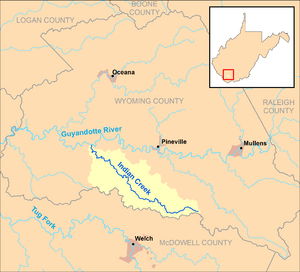Indian Creek (Guyandotte River tributary) facts for kids
Quick facts for kids Indian Creek |
|
|---|---|

Indian Creek and its watershed in Wyoming County, West Virginia
|
|
| Country | United States |
| State | West Virginia |
| County | Wyoming |
| Physical characteristics | |
| Main source | southeastern Wyoming County 2,315 ft (706 m) 37°28′59″N 81°27′30″W / 37.4831698°N 81.4584366°W |
| River mouth | Guyandotte River east of Baileysville 1,132 ft (345 m) 37°35′13″N 81°39′53″W / 37.5870558°N 81.6648324°W |
| Length | 19.7 mi (31.7 km) |
| Basin features | |
| Basin size | 43 sq mi (110 km2) |
Indian Creek is a stream located in southern West Virginia, United States. It is about 19.7 miles (31.7 km) long. This creek is a tributary, meaning it flows into a larger river. Indian Creek joins the Guyandotte River. Through the Guyandotte and then the Ohio River, its waters eventually reach the mighty Mississippi River. This makes Indian Creek part of a very large drainage basin.
Where Does Indian Creek Flow?
Indian Creek is found entirely within Wyoming County, West Virginia. It starts in the southeastern part of the county. The creek begins about 5 miles (8 km) south of a place called New Richmond. From there, it generally flows towards the northwest.
As it travels, Indian Creek passes through several small, unincorporated communities. These include Wolf Pen, Fanny, and Fanrock. The creek then flows into the Guyandotte River. This meeting point is about 0.3 miles (0.5 km) east of Baileysville. A section of West Virginia Route 16 runs alongside the middle part of the creek.
Understanding the Indian Creek Watershed
A watershed is an area of land. All the rain and snow that falls on this land drains into a specific river or stream. The Indian Creek watershed covers about 43 square miles (111 km²). This area is mostly rural. It is part of the Allegheny Plateau, which is a large, raised area of land.
According to the West Virginia Department of Environmental Protection, most of the Indian Creek watershed is covered by trees. About 97.7% of the land is forested. These forests are mainly made up of deciduous trees. Deciduous trees are those that lose their leaves every autumn.

